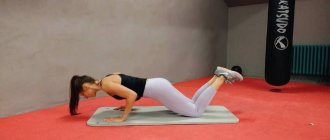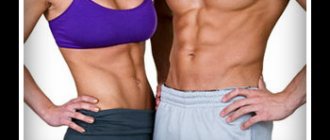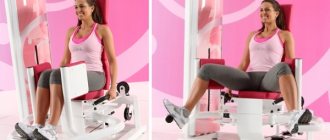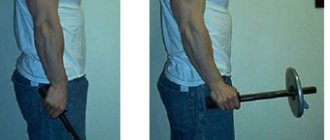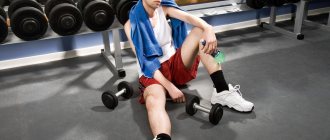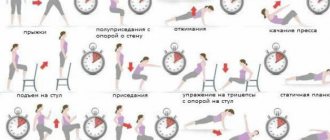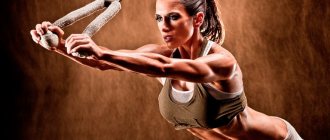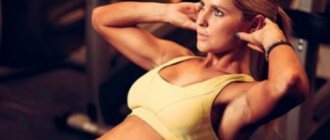The effectiveness of training directly depends on your health and energy level. During menstruation, health worsens, and therefore nutrition and exercise during menstruation should change. How radically depends on the individual characteristics of the organism.
It is important to understand that every woman’s body undergoes cyclical hormonal changes that need to be taken into account. If you take into account the phases of the menstrual cycle when creating your diet and workout schedule, you can get better results and get a beautiful and healthy body.
Critical days
Let's start with the fact that menstruation is not a disease, but a natural physiological process. This is a monthly hormonal reaction of the body of a sexually mature woman or girl. But this process goes differently for everyone. Probably not! – women experience this very individually. Due to the fact that during menstruation there is a loss of fluid in the body, muscle tone decreases. Natural blood loss occurs. This leads to a slight decrease in hemoglobin in the blood. Which can also give a feeling of weakness.
The woman’s condition during this period is influenced by:
- length of the menstrual cycle,
- abundance of discharge,
- presence of pain,
- age,
- weather,
- general psycho-emotional state.
Some are still active these days. And many experience headaches, stomach pains and even nausea. Therefore, a natural question arises for many: is it possible to continue training during menstruation? Will fitness during menstruation bring benefit or harm to my body? Let's divide these questions into separate blocks, since the recommendations for female athletes are slightly different from the recommendations for those who simply engage in fitness for their own pleasure.
When should you not exercise?
If you have endometriosis. Endometriosis is a hormone-dependent benign pathological growth of the glandular tissue of the uterus (endometrium) outside of it: in the ovaries, in the fallopian tubes, in the thickness of the uterus, in the bladder, on the peritoneum, in the rectum and other, more distant organs. These same growths that appear in other organs react to the phases of the menstrual cycle in the same way as the endometrium in the uterus.
These changes in the endometrium are manifested by pain, an increase in the affected organ in volume, monthly bleeding, menstrual dysfunction, discharge from the mammary glands, and infertility.
In the presence of such syndromes:
- Painful sexual intercourse (dyspareunia).
- Pain when defecating or urinating.
- Heavy and prolonged menstruation
- Pelvic pain.
- Acquired anemia: begins as a result of significant chronic blood loss during menstruation. Characterized by weakness, pallor or yellowness of the skin and mucous membranes, drowsiness, fatigue, dizziness.
- Infertility.
SEE THE DOCTOR URGENTLY! In this case, sports should be strictly dosed and stopped during menstruation.
Prevention
- TO GIVE UP SMOKING . Smoking is enemy number 1 not only for patients with endometriosis, but also for weight loss, for blood vessels and the beauty of your legs ;
- Regular visits and examinations by a gynecologist during painful menstruation in order to exclude endometriosis;
- Taking oral hormonal contraceptives (again, strictly as prescribed by a doctor);
- Proper nutrition , eliminating junk food from the diet ;
- One theory for the development of endometriosis: lesions spread throughout the body by throwing menstrual blood through the fallopian tubes into the abdominal cavity, where endometrial cells take root and form lesions.
Blood circulation is facilitated by active aerobics, gymnastics, figure skating, acrobatics, physical exercises on sports equipment (uneven bars, beam, horizontal bar, etc.), exercises where the pelvis rises above the level of the torso . Therefore, physical activity in cases of endometriosis should be prescribed by a doctor and EXCLUDED during menstruation. - Refusal of the uterine device .
As a preventative measure, you SHOULD AVOID yogic inverted asanas, gluteal bridges, and abdominal swings on an inclined bench during menstruation.
Risk group
- Ladies who are obese or overweight;
- those who have undergone uterine surgery, uterine curettage and abortion;
- smokers;
- using intrauterine contraceptives (spirals);
- after the age of 30-35 years, although endometriosis can also appear in a 16-year-old girl;
- having a hereditary predisposition;
Menstruation and sports
Girls who have been involved in professional sports since adolescence know how to behave on critical days. They studied the symptoms and learned to adapt. After all, games or competitions may often fall during your period. But nature cannot be stopped.
The trainer gives rest only on the first day of your period. Professional athletes usually keep a schedule of their menstrual cycles and record observations of their physical condition on critical days. The trainer does not give strength training during menstruation, but general physical activity remains.
Under what conditions should you not exercise?
Gynecological diseases affect the ability to play sports during menstruation. Endometriosis and fibroids themselves are accompanied by:
- heavy bleeding;
- prolongation of menstruation up to 10 days;
- pain in the lower abdomen and lower back;
- deterioration of general condition;
- anemia.
Playing sports with these diseases will negatively affect your health, so it is recommended to avoid them during menstruation.
Training for girls during menstruation is also contraindicated if there are the following symptoms:
- painful cramps in the lower abdomen;
- general weakness, dizziness;
- heavy bleeding;
- diseases of the genitourinary system.
If you are worried about dysmenorrhea, the menstrual cycle is irregular, and disruptions often occur, then you do not need to give a large load before menstruation. Menstruation may be delayed due to sports activities.
Working out in the gym during your period
Are you used to regular workouts in the gym? You don’t want to interrupt your studies on “these” days, but doubts still remain?
Here are some simple tips:
- Assess your physical condition on critical days;
- Contact your fitness trainer - he will determine what loads and exercises are suitable for you in this condition;
- When performing exercises, pay attention to the body’s reaction and try to listen to your body;
- Try to reduce the intensity of your exercises, limit working with heavy weights in the gym - instead rely on working with your own weight, stretching, Pilates or yoga.
If you are not tormented by pain, weakness and dizziness, you can not interrupt your training. Do them at a relaxed pace. Moderate loads are even useful, as they improve blood circulation, prevent blood stagnation in the pelvic area and help the natural removal of fluid from the uterus. Therefore, we can say that physical activity makes the course of critical days easier. But avoid excessive stress and strength exercises!
Phase III (day 12-15 of the cycle)
Ovulation occurs on days 12-15 of the cycle. This is exactly the period when hormones are at their maximum, a woman feels more confident and is in a state of “can do anything.” If you feel good during ovulation, give your best in training.
But some women feel a loss of strength, so you should reduce the intensity of your workouts and eliminate exercises that increase intra-abdominal pressure. Such exercises include barbell squats, deadlifts, leg presses, and lunges.
Workouts at home on critical days
Many people want to look good and keep fit by doing fitness at home. We offered many recommendations and exercises for losing weight at home in our blog:
At home, you decide whether to exercise during your period or not. If possible, you can consult your gynecologist. We are sure that he will give you the necessary recommendations based on your state of health. In any case, your decision will be based on an assessment of your own well-being. After all, it doesn’t happen once at a time.
And our recommendations are simple - during menstrual periods, avoid:
- Power loads,
- Lower abdominal exercises
- Squats - with or without weights.
You can jog for short distances. Pay attention to stretching. Do flexibility exercises. Practice yoga and Pilates. Another frequently asked question is: is it possible to go swimming while on your period? Many trainers and even gynecologists recommend swimming on menstrual days. But only in the pool. Open bodies of water should be avoided, as there is a risk of contracting a bacterial infection. To feel comfortable in the water, even with hygienic protective equipment, we recommend not visiting the pool on the first and second days of your period. During this period, discharge is especially abundant. And one more important question: Is it possible to do physical education at school during menstruation?
Estrogen, the menstrual cycle and exercise: a technical side of the issue.
I’ll say right away that the article is tailored specifically for young ladies, however, if guys read it and convey the main points to their other half, then I’m all for it.
I’m sure every man has heard the words at least once in his life: “my head hurts, let’s put it off” or “sorry, not today, critical days.” Most of them (us) think that girls come up with this on purpose to discourage them from the forbidden fruit, which is so sweet. Such male thoughts arise simply due to a misunderstanding (or ignorance) of banal issues of physiology, biochemistry and endocrinology (hormones) of the male and especially female body. Representatives of the male sex reason like this - if I want and I don’t have any critical days, it means that the young lady is dark about something, maybe she’s just dynamite for me?
Few people actually truly understand the intricacies of female physiology than herself or her gender comrade. And even no matter how sensitive a young man is, he still cannot understand these delicacies, and all because we are from different planets: a woman is from Venus, a man is from Mars.
Well, closer to the body.
Menstruation, also known as critical days (menstruation), as well as the previous state of PMS (premenstrual syndrome) are certain physiological and hormonal changes that occur in the body 85%
women of childbearing age. I think it’s not worth listing what changes these are, because the young ladies themselves are aware of their illnesses, and the fragile psyche of the guys can simply crack :). In a nutshell, the woman’s behavior during this period can be characterized as: it’s better not to touch me, if you come up, you’ll get hit in the forehead, everything infuriates me and other rosy thoughts. However, this is not so bad when there is an opportunity to wait out such a storm in a quiet harbor. What if a girl is active, watches her figure, does fitness, and doesn’t want any critical days to prevent her from becoming Aphrodite? In such cases, a completely reasonable question arises: is it possible to do fitness during menstruation, how safe is it and is it worth bothering with? We will try to answer all these questions in today’s post.
Well, we’ll start with physiology, or more precisely, with the hormonal side of the issue, and even more precisely, with estrogen.
Note:
All further narration will take place in the form of “question and answer” for better assimilation of the material.
No. 1. What is estrogen?
Estrogen is a female sex hormone (FSH) that makes a woman a woman (and not the gait that Verochka told her director about in the film “Office Romance”). In fact, the concentration of estrogen in women is higher, which is why the name GPG was assigned to it, but in men this hormone is also present (in smaller quantities), and it can also take a leading position.
There are several forms of this steroid hormone, in particular:
- Estradiol (sometimes called E2) is the most potent form of estrogen. Produced by the ovaries;
- estriol (known as E3) is produced during pregnancy;
- estrone (known as E1) is the most dominant estrogen in menopausal women.
Most often, when people talk about estrogen, they mean estradiol. Estrone and estriol make up 1/10
estradiol potency.
No. 2. How does the body produce estrogen?
Estrogen, like other sex hormones, is synthesized from cholesterol. It is created through a complex process of androgen conversion. It is believed that male and female hormones are opposites, this is true. However (as the diagram of one scientific study shows), in the early stages the synthesis of estradiol and testosterone (including other androgens) is exactly the same.
Estradiol is formed if the base (substrate) is testosterone. During perimenopause, the most important producer of estrogen is the ovaries. In the period after menopause, adipose tissue (fat) comes to the fore in the production of estrogen. In men, the main source of estrogen is testosterone. Because Adipose tissue can produce hormones, and its excess in the body can lead to disruption of the correct hormonal balance.
No. 3.
Estrogen regulation, or what is the signal for estrogen production?
The hypothalamus secretes a hormone known as gonadotropin-releasing hormone (gonadorelin, GnRH). It regulates the secretion of lutropin (LH) and follicle-stimulating hormones (FSH) released by the pituitary gland. These two hormones stimulate the ovaries to secrete estrogen. The female hormone is released in pulses at intervals of 1
up to
3
hours.
Hormones can circulate in the body in two forms - “bound” and “unbound”. Bound hormones are attached to something, such as a transport protein (globulin) that binds sex hormones. Unbound hormones, hanging around and circulating freely. Once released, only unbound estrogen has biological activity.
Well, how do you like the theory, nothing is understood at all? - these are just flowers, a joke. It will be easier later.
- these are just flowers, a joke. It will be easier later.
No. 4. Why is estrogen important?
Estrogens are the most important regulators of many important processes in the body. For example:
- they greatly influence the deposit of fat - quantity and location;
- affect muscle mass;
- estradiol has cardioprotective properties (protects against cardiovascular diseases);
- Estrogen prevents the breakdown of bone tissue and can stimulate the formation of new tissue through synthesis.
No. 5. Menstrual cycle.
Estradiol levels (red line in the figure) typically fluctuate throughout a woman's menstrual cycle, peaking before ovulation and falling during menstruation.
Note:
The average menstrual cycle lasts up to 28
days.
The researchers examined whether these cyclical changes had an impact on women's physical performance (exercise performance) and body composition.
No. 6. Stress hormone.
The menstrual cycle has little effect on secretion during exercise. When exercise occurs during a period of high estradiol levels, cortisol secretion remains virtually unchanged. Aldosterone secretion is higher during these times, and may contribute to increased fluid retention.
No. 7. Fuel use.
Fluctuations in estrogen during the menstrual cycle have minimal impact on fuel use. Lipid utilization may be higher during the luteal phase following ovulation.
Increases in estradiol, free fatty acids, and triglycerides in muscle and adipose tissue increase the mobilization of fatty enzymes during exercise. In other words, fats (rather than carbohydrates) are used more as a fuel source.
No. 8. Fat deposits.
An increase in masculinization hormones coupled with a decrease in estrogen in women is associated with higher levels of intra-abdominal fat in the body (apple-shaped body type).
No. 9. Exercise and hormones.
Doing moderate to vigorous intensity exercise is associated with an increase in sex hormones. Men show little change in estradiol and estrone in response to exercise. In women, the increase in estrogen is proportional to the intensity of exercise and is more noticeable during the luteal than during the follicular phase of the menstrual cycle. Increases in plasma progesterone levels occur only during the luteal phase of the cycle.
So, in general terms we have understood the physiological side and the influence of menstruation on a woman’s body. These are the conclusions that need to be drawn at this stage. In order for a girl to maintain high estrogen levels, she needs:
- eat enough quality calories;
- avoid in the hall;
- maintain a healthy level of fat ( 13-18%
before
30
and
15-23%
before
age 50
) in the body; - avoid the use of various androgens (including supposedly harmless ones from the pharmacy);
- control the level of intensity of exercise (should not be too high).
Actually, this was the technical side of the issue, now let’s move towards practice, namely, let’s find out...
Exercises to reduce pain during menstruation
There are exercises that alleviate the condition of women with painful menstruation. You need to do them no more than 20 minutes a day, but the result will be good health and a surge of strength. It is better to start doing them before the start of your critical days. Then, perhaps, menstruation will begin less painfully.
Pain is usually caused by muscle spasm, and therefore a set of exercises aimed at relaxation is needed:
- Lie on your back, put a small weight (0.5-1 kg) on your stomach. Inhale air deeply through your nose, filling your stomach (slowly). Hold your breath, count to 5 and exhale just as slowly.
- Lie on your stomach, join your legs and straighten them. Palms rest on the floor near the face. Exhale and lift your upper body off the floor, straightening your arms. If you feel tension in your buttocks, you should stop in this position for 30 seconds. Then take the starting position.
- Get on your knees and sit on your heels. Hands lie at your sides throughout the entire exercise. Bend your torso forward, touching your forehead to the surface of the floor. Take a few breaths in this position and take your starting position.
- Get on all fours, raising your buttocks as much as possible. Stay in this position for 15-20 seconds and relax.
- Lying on your back, bend your knees and, hugging them with your arms, press them to your stomach. Stay like this for 2-3 minutes.
- While kneeling, straighten your back and place your hands on your waist. Stretch your head towards the ceiling and bend your back back. Then put your hands on your feet and stay in this position for a couple of minutes.
- Several low squats, which must be performed quickly, will help relieve sharp pain.
Of course, such a workout will not get rid of extra pounds and will not help build muscles. But during this period, the main task for a woman is to improve her well-being and health. Regularly performing such exercises will have a good effect on subsequent cycles.
conclusions
To summarize, the postmenstrual stage is most favorable for athletic performance. But the time of menstruation is characterized by a decrease in reaction speed and neuromuscular coordination. Thus, the period from the end of menstruation, about 14 days, until ovulation is the best time for sports activities.
In order to help and not harm your body, you need to balance the intensity of your training with the characteristics of each phase of the cycle. With all this information, it will no doubt be possible to create a more specific and personalized training plan.
